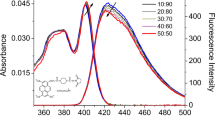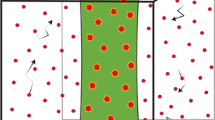Abstract
The motional properties of rhodamine green alone and conjugated to 10-kDa dextran have been studied by fluorescence correlation spectroscopy (FCS) and time-resolved fluorescence anisotropy (TRFA). With FCS the translational diffusion times of the fluorescent particles can be determined, which are directly proportional to the shear viscosity as shown in aqueous solutions of different sucrose concentrations. With TRFA the rotational correlation times of the fluorescent particles can be determined. TRFA experiments in the case of fluorescent dextran reveal a distinct restricted internal motion of the fluorescent probe independent of the slower overall rotation of the polysaccharide. The fast depolarization is most likely due to internal motion and not to energy transfer between different rhodamine green molecules in the same dextran, since a higher viscosity of the solvent increases the correlation time for internal motion proportionally. FCS and TRFA yield complementary information in the sense that the correlation time for overall dextran rotation can be accurately determined from the translational diffusion coefficient.
Similar content being viewed by others
REFERENCES
M. Eigen and R. Rigler (1994) Proc. Natl. Acad. Sci. USA 91, 5740–5747.
S. Maiti, U. Haupts, and W. W. Webb (1997) Proc. Natl. Acad. Sci. USA 94, 11753–11757.
R. P. Haugland (1996) Handbook of Fluorescent Pobes and Research Chemicals, 6th ed., Molecular Probes, Eugene, OR, pp. 351–357.
P. I. H. Bastiaens, A. van Hoek, W. F. Wolkers, J. C. Brochon, and A. J. W. G. Visser (1992) Biochemistry 31, 7050–7060.
P. A. W. van den Berg, A. van Hoek, C. D. Walentas, R. N. Perham, and A. J. W. G. Visser (1998) Biophys. J. 74, 2046–2058.
Handbook of Chemistry and Physics, 56th ed. (1975) CRC Press, Cleveland, p. D-261.
R. E. Dale, J. Eisinger, and W. E. Blumberg (1979) Biophys. J. 26, 161–194.
A. Szabo (1984) J. Chem. Phys. 81, 150–167.
Author information
Authors and Affiliations
Rights and permissions
About this article
Cite this article
Visser, N.V., Hink, M.A., van Hoek, A. et al. Comparison Between Fluorescence Correlation Spectroscopy and Time-Resolved Fluorescence Anisotropy as Illustrated with a Fluorescent Dextran Conjugate. Journal of Fluorescence 9, 251–255 (1999). https://doi.org/10.1023/A:1022515902867
Issue Date:
DOI: https://doi.org/10.1023/A:1022515902867




